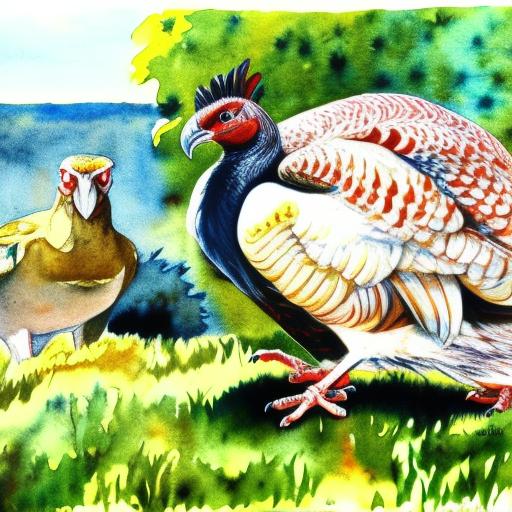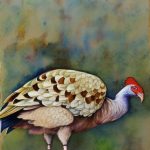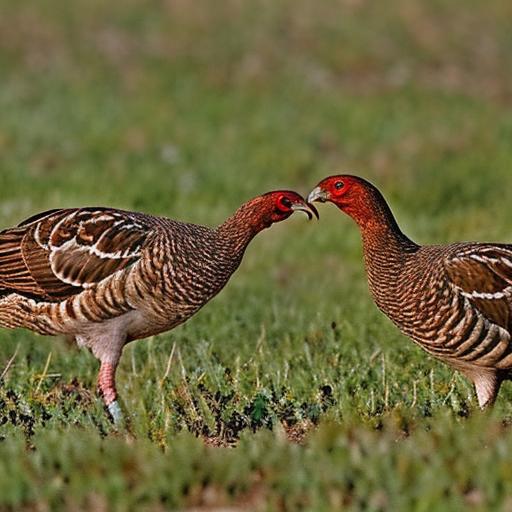Turkey breeder houses are facilities specifically designed for the purpose of raising turkeys for breeding. These houses are equipped with the necessary infrastructure and technology to provide a controlled environment for the turkeys, ensuring their health and well-being. The primary goal of turkey breeder houses is to maintain a healthy and productive population of turkeys for the purpose of producing fertile eggs, which are then used for hatching and raising turkeys for meat production.
Turkey breeder houses play a crucial role in the turkey production industry, as they are responsible for maintaining the genetic diversity and overall health of the turkey population. The success of a turkey breeder house is dependent on the ability to monitor and manage the turkey population effectively, ensuring that the birds are healthy, productive, and free from disease. Monitoring the turkey population in breeder houses is essential for maintaining optimal conditions for breeding and ensuring a consistent supply of high-quality turkeys for meat production.
Key Takeaways
- Turkey breeder houses are essential for the production of turkey eggs and poults, and they require careful monitoring to ensure optimal population management.
- Monitoring turkey population is crucial for maintaining the health and productivity of the flock, as well as for making informed decisions about breeding and production.
- Factors such as temperature, lighting, nutrition, and disease can significantly impact turkey population in breeder houses, making regular monitoring and adjustments necessary.
- Methods for counting turkeys in breeder houses include manual counting, automated systems, and video monitoring, each with its own advantages and limitations.
- Challenges in counting turkeys in breeder houses include accuracy, time constraints, and the need for specialized training, which can impact the reliability of population data and management decisions.
The Importance of Monitoring Turkey Population
Monitoring the turkey population in breeder houses is essential for several reasons. Firstly, it allows for the early detection of any potential health issues or diseases that may affect the turkeys. By closely monitoring the population, breeders can quickly identify any signs of illness or distress and take appropriate measures to prevent the spread of disease and ensure the overall health of the birds.
Secondly, monitoring the turkey population allows breeders to track the productivity of the birds. By keeping a close eye on the number of eggs laid and the hatch rates, breeders can assess the overall performance of the turkey population and make informed decisions about breeding practices and genetic selection.
Furthermore, monitoring the turkey population is crucial for maintaining optimal living conditions within the breeder house. By keeping track of the population size and behavior, breeders can make adjustments to the environment, such as temperature, humidity, and ventilation, to ensure that the turkeys are comfortable and healthy.
Overall, monitoring the turkey population in breeder houses is essential for maintaining the health, productivity, and overall well-being of the birds, as well as ensuring a consistent and high-quality supply of turkeys for meat production.
Factors Affecting Turkey Population in Breeder Houses
Several factors can affect the population of turkeys in breeder houses. One of the most significant factors is disease and illness. Disease outbreaks can quickly spread through a turkey population, leading to high mortality rates and reduced productivity. It is essential for breeders to closely monitor the health of the birds and implement strict biosecurity measures to prevent the spread of disease within the breeder house.
Another factor that can affect the turkey population is environmental conditions. Turkeys are sensitive to changes in temperature, humidity, and ventilation, and any fluctuations in these factors can impact their health and productivity. It is crucial for breeders to maintain optimal environmental conditions within the breeder house to ensure the well-being of the turkeys.
Genetic factors also play a significant role in determining the population of turkeys in breeder houses. Breeders must carefully select breeding stock to maintain genetic diversity and prevent inbreeding, which can lead to health issues and reduced fertility in the turkey population.
Additionally, management practices, such as feeding, lighting, and handling, can also impact the turkey population. Proper management practices are essential for ensuring that the turkeys are healthy, productive, and well-adjusted to their environment.
Overall, there are several factors that can affect the population of turkeys in breeder houses, and it is essential for breeders to carefully monitor and manage these factors to maintain a healthy and productive turkey population.
Methods for Counting Turkeys in Breeder Houses
There are several methods for counting turkeys in breeder houses, each with its advantages and limitations. One common method is visual inspection, where breeders physically count the turkeys by walking through the house and visually assessing the population. While this method is straightforward and cost-effective, it can be time-consuming and may not be suitable for large breeder houses with thousands of turkeys.
Another method for counting turkeys is using automated counting systems, such as cameras or sensors. These systems can provide accurate and real-time data on the turkey population, allowing breeders to monitor changes in population size more efficiently. However, these systems can be expensive to install and maintain, and they may require technical expertise to operate effectively.
Some breeders also use statistical sampling methods to estimate the turkey population. By counting a representative sample of turkeys and extrapolating the data, breeders can estimate the total population size with a certain degree of confidence. While this method can provide useful estimates, it may not be as accurate as physically counting every bird.
Overall, there are several methods for counting turkeys in breeder houses, each with its advantages and limitations. Breeders must carefully consider their specific needs and resources when choosing a method for monitoring the turkey population.
Challenges in Counting Turkeys in Breeder Houses
Counting turkeys in breeder houses can present several challenges for breeders. One significant challenge is the sheer size of some breeder houses, which can make it difficult to accurately count every bird. Large houses with thousands of turkeys may require significant time and resources to conduct a thorough count using traditional methods.
Another challenge is the behavior of turkeys, which can be unpredictable and may make it difficult to get an accurate count. Turkeys may move around frequently, making it challenging to keep track of individual birds and accurately assess the total population size.
Additionally, environmental factors such as poor lighting or obstructed views can make it challenging to visually inspect the turkey population accurately. Breeders must ensure that they have adequate lighting and unobstructed views within the breeder house to conduct an accurate count.
Furthermore, automated counting systems may present their own challenges, such as technical malfunctions or inaccuracies in data collection. Breeders must carefully maintain and calibrate these systems to ensure that they provide reliable data on the turkey population.
Overall, counting turkeys in breeder houses can present several challenges for breeders, including the size of the house, turkey behavior, environmental factors, and technical limitations of automated counting systems. Breeders must carefully consider these challenges when monitoring the turkey population and choose methods that are suitable for their specific needs.
Implications of Turkey Population in Breeder Houses

The population of turkeys in breeder houses has significant implications for the turkey production industry. A healthy and productive turkey population is essential for maintaining a consistent supply of high-quality turkeys for meat production. A decline in the turkey population due to disease outbreaks or other factors can have severe economic consequences for breeders and the broader industry.
Furthermore, maintaining a healthy turkey population is crucial for preserving genetic diversity within the turkey population. Genetic diversity is essential for preventing inbreeding and maintaining overall health and fertility in turkeys. A decline in genetic diversity can lead to health issues and reduced productivity in the turkey population.
The turkey population also has implications for animal welfare, as a healthy and well-managed population is essential for ensuring that turkeys are comfortable and free from stress or illness. Breeders must carefully monitor and manage the turkey population to ensure that they provide optimal living conditions for the birds.
Overall, the population of turkeys in breeder houses has significant implications for the turkey production industry, including economic consequences, genetic diversity, and animal welfare considerations. Breeders must carefully monitor and manage the turkey population to ensure that they maintain a healthy and productive population of turkeys.
Conclusion and Future Considerations
In conclusion, monitoring the turkey population in breeder houses is essential for maintaining a healthy and productive population of turkeys. Several factors can affect the turkey population, including disease outbreaks, environmental conditions, genetic factors, and management practices. Breeders must carefully monitor these factors to ensure that they maintain optimal conditions for breeding and produce a consistent supply of high-quality turkeys for meat production.
Counting turkeys in breeder houses presents several challenges for breeders, including house size, turkey behavior, environmental factors, and technical limitations of automated counting systems. Breeders must carefully consider these challenges when monitoring the turkey population and choose methods that are suitable for their specific needs.
The implications of the turkey population in breeder houses are significant for the turkey production industry, including economic consequences, genetic diversity considerations, and animal welfare implications. Breeders must carefully monitor and manage the turkey population to ensure that they maintain a healthy and productive population of turkeys.
In the future, advancements in technology may provide new opportunities for monitoring and managing the turkey population more effectively. Automated counting systems and other technological innovations may offer more efficient ways to track changes in population size and behavior. Additionally, ongoing research into disease prevention and genetic selection may provide new insights into maintaining a healthy and productive turkey population in breeder houses.
Overall, monitoring and managing the turkey population in breeder houses will continue to be a critical aspect of turkey production, with implications for economic success, genetic diversity, and animal welfare considerations. Breeders must remain vigilant in their efforts to maintain a healthy and productive turkey population while embracing new technologies and research advancements to improve their practices.
Sure, here’s the paragraph with the related article included as an tag:
If you’re interested in learning more about poultry farming, you might want to check out this article on when guinea fowl lay eggs. It provides valuable insights into the breeding habits of guinea fowl and could offer some useful tips for managing a breeder house for turkeys. Understanding the breeding patterns of different poultry species can help you optimize your farming practices and ensure the health and productivity of your flock.
FAQs
How many turkeys are typically in a breeder house?
The number of turkeys in a breeder house can vary depending on the size of the facility and the specific management practices of the farm. However, a typical breeder house may house anywhere from 5,000 to 10,000 turkeys.
What is the purpose of a breeder house?
A breeder house is specifically designed for the purpose of housing turkeys that are used for breeding. These turkeys are selected for their genetic traits and are used to produce fertile eggs that will hatch into the next generation of turkeys.
How are turkeys housed in a breeder house?
Turkeys in a breeder house are typically housed in large, open barns with plenty of space for the birds to move around. The barns are equipped with feeding and watering systems, as well as environmental controls to ensure the turkeys are kept in optimal conditions for breeding.
What are the management practices for turkeys in a breeder house?
The management practices for turkeys in a breeder house include monitoring the health and well-being of the birds, providing a balanced diet, and ensuring that the environmental conditions are suitable for breeding. Additionally, the turkeys are often monitored for reproductive performance and egg production.
Are there any regulations or guidelines for breeder houses?
In many countries, there are regulations and guidelines that govern the operation of breeder houses to ensure the welfare of the turkeys and the safety of the food supply. These regulations may cover aspects such as housing conditions, biosecurity measures, and animal welfare standards.
Meet Walter, the feathered-friend fanatic of Florida! Nestled in the sunshine state, Walter struts through life with his feathered companions, clucking his way to happiness. With a coop that’s fancier than a five-star hotel, he’s the Don Juan of the chicken world. When he’s not teaching his hens to do the cha-cha, you’ll find him in a heated debate with his prized rooster, Sir Clucks-a-Lot. Walter’s poultry passion is no yolk; he’s the sunny-side-up guy you never knew you needed in your flock of friends!







